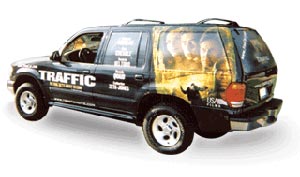Saturday, December 02, 2006
Get paid for drive.

Icarfinder
Everyday, Americans cannot afford their car payments. As a result, their new and almost new cars are seized and sold in a hurry because the storing costs are very expensive for the amount of cars they have.
They need to get rid of these cars as fast as possible and they are willing to take almost any price for the amazing cars. Because of our updated databases, you can find the nearest auction and get a car at an unbelievable price!
Why So Cheap?
Thousands of cars become government & bank property every day through various seizure and surplus laws. The constant exchange of vehicles and the enormous expense to store them, means amazing deals and guaranteed rock bottom prices for you! As Much as 80% - 90% OFF!
Make buying your new car fun by purchasing through government & surplus auctions!
LPG: an assessment of alternative fuels by Daniel Muir
Availability of alternative fuels by number of stations (www.energysavingstrust.co.uk):
LPG- 1228 Biodiesel-138 Natural gas- 31 Electricity-12 Bioethanol-10 Hydrogen-0
LPG is by far the most available alternative fuel. This enables more customers to be targeted and more customers are also more able to reach the fuel stations making it a more attractive option for customers. LPG is best suited to 'thirsty' fuel consuming cars or cars which have a high annual mileage. LPG cars bring many benefits i.e. less toxic emissions, cost savings per mile and congestion zone discounts.
Another option is biodiesel, which is biodegradable and better for the environment. It doesn't really affect vehicles in a bad way and could make the engine run more smoothly. It is about the same price as diesel and generally believed to be better for the environment.
Natural gas is mainly used in trucks and buses etc, and includes benefits including being much quieter than diesel cars, less toxic emissions and a congestion zone discount. Drawbacks include low availability and large storage is needed.
Electricity is thought of as the ideal sustainable transport solution but in order to be 'zero emission' must be produced using a renewable energy source. Performance is similar or improved but barriers include high cost, lack of investment and large storage tanks are needed.
Bioethanol is again much better for the environment but running costs are similar to petrol and there is very limited availability.
Lastly, hydrogen is almost pollution-free but is still at an early stage in development and can cost up to 20 times more than petrol. There is currently no availability but there is potential for growth.
Undoubtedly, at the moment, LPG appears to be the best option due to its availability and benefits and will be looking to become even more widely known and used in the future.
LPG- 1228 Biodiesel-138 Natural gas- 31 Electricity-12 Bioethanol-10 Hydrogen-0
LPG is by far the most available alternative fuel. This enables more customers to be targeted and more customers are also more able to reach the fuel stations making it a more attractive option for customers. LPG is best suited to 'thirsty' fuel consuming cars or cars which have a high annual mileage. LPG cars bring many benefits i.e. less toxic emissions, cost savings per mile and congestion zone discounts.
Another option is biodiesel, which is biodegradable and better for the environment. It doesn't really affect vehicles in a bad way and could make the engine run more smoothly. It is about the same price as diesel and generally believed to be better for the environment.
Natural gas is mainly used in trucks and buses etc, and includes benefits including being much quieter than diesel cars, less toxic emissions and a congestion zone discount. Drawbacks include low availability and large storage is needed.
Electricity is thought of as the ideal sustainable transport solution but in order to be 'zero emission' must be produced using a renewable energy source. Performance is similar or improved but barriers include high cost, lack of investment and large storage tanks are needed.
Bioethanol is again much better for the environment but running costs are similar to petrol and there is very limited availability.
Lastly, hydrogen is almost pollution-free but is still at an early stage in development and can cost up to 20 times more than petrol. There is currently no availability but there is potential for growth.
Undoubtedly, at the moment, LPG appears to be the best option due to its availability and benefits and will be looking to become even more widely known and used in the future.
About the Author
This Article was written by Daniel Muir for Fuelture Ltd. Fuelture Ltd is a UK based alternative fuel company with a national LPG conversion service. Fuelture Ltd aspires to build a unique network of state-of-the-art LPG Stations and to launch a unique
Gas Powered Rc Cars by June Mala
When it comes to RC cars, electricity saves you money, but gas makes it real. Gas powered RC cars go faster, sound more realistic and give you the thrill of the race in a way that their electrically controlled counterparts just can't do. Of course, you have to understand that when you hear the term gas powered RC cars, you're really not talking about gasoline.
Gas powered RC cars are actually powered by a fuel combination more often referred to as nitro. But even if you don't actually put gasoline into the cars, gas powered RC cars still look for all the world like miniature automobiles as they zoom at high speeds around the track.
Gas powered RC cars have engines that require fine tuning and that roar with all the excitement of a full sized car. In fact, the faster they go, the louder they get, just like the real thing. The excitement of racing gas powered RC cars doesn't end with the sounds however. As they face like lightning, vapor trails of exhaust shadow their route. That's a sight that you just can't get from electrically controlled RC cars.
Aside from the cool sounds and sights, there are some other differences. Typical gas powered RC cars get owe their higher sense of realism to an internal combustion engine. The "gas" is actually a nitro methane fuel mixed with lubricating oil to protect the engine. The replace for a real car's spark plugs in gas powered RC cars is something called a glow plug.
This plug is heated by a battery-powered starter that continuously ignites the fuel, allowing gas powered RC cars to race far longer at a time than electric ones. Unless, that is, your glow plug goes out on you. Because this eventuality is not exactly unknown in the world of gas powered RC racing, it always pay to invest in a backup or two.
If you are still reading this, that means you are probably new to the world of gas powered RC cars and maybe haven't even bought one yet. Rather than starting out with a top of the line model, you should probably go for entry-level car. Most of these models don't need electric starters because they come with pull-starters like a go-kart engine. If you do get one that comes without this, you'll have to invest in a starter. You have a choice here: either an electric starter box or a 12V starter with a car adaptor.
Gas powered RC cars bring the excitement of RC car racing to another level. The sounds, the sights and even the smells of a race between gas powered RC cars are so much more realistic than a race between electric cars. If you are looking to get in on one of the fastest growing hobbies in America and you truly want to experience it to the ultimate, then gas powered RC cars is really your only choice.
About the Author
Author: June Mala © 2006 www.NkPk.com
Gas powered RC cars are actually powered by a fuel combination more often referred to as nitro. But even if you don't actually put gasoline into the cars, gas powered RC cars still look for all the world like miniature automobiles as they zoom at high speeds around the track.
Gas powered RC cars have engines that require fine tuning and that roar with all the excitement of a full sized car. In fact, the faster they go, the louder they get, just like the real thing. The excitement of racing gas powered RC cars doesn't end with the sounds however. As they face like lightning, vapor trails of exhaust shadow their route. That's a sight that you just can't get from electrically controlled RC cars.
Aside from the cool sounds and sights, there are some other differences. Typical gas powered RC cars get owe their higher sense of realism to an internal combustion engine. The "gas" is actually a nitro methane fuel mixed with lubricating oil to protect the engine. The replace for a real car's spark plugs in gas powered RC cars is something called a glow plug.
This plug is heated by a battery-powered starter that continuously ignites the fuel, allowing gas powered RC cars to race far longer at a time than electric ones. Unless, that is, your glow plug goes out on you. Because this eventuality is not exactly unknown in the world of gas powered RC racing, it always pay to invest in a backup or two.
If you are still reading this, that means you are probably new to the world of gas powered RC cars and maybe haven't even bought one yet. Rather than starting out with a top of the line model, you should probably go for entry-level car. Most of these models don't need electric starters because they come with pull-starters like a go-kart engine. If you do get one that comes without this, you'll have to invest in a starter. You have a choice here: either an electric starter box or a 12V starter with a car adaptor.
Gas powered RC cars bring the excitement of RC car racing to another level. The sounds, the sights and even the smells of a race between gas powered RC cars are so much more realistic than a race between electric cars. If you are looking to get in on one of the fastest growing hobbies in America and you truly want to experience it to the ultimate, then gas powered RC cars is really your only choice.
About the Author
Author: June Mala © 2006 www.NkPk.com
Used Car Buying Tips by Jake Newberry
For most of us, purchasing a new car isn't an everyday experience. For this reason buying a new car is a thrilling event. Even if you are buying a used car, it is still new and exciting to you. However, there are a handful of things to check before making a purchase on a used car. Most important is taking a test drive.
After browsing over thousands of ads in the newspaper or peeking at a handful of cars on the lot, you likely have found at least one that you would be interested in. The next step is to ask for some more information and then take a test drive. The first test drive you should merely be checking the overall fit of the car. One helpful tip is to first turn on the radio to make sure it works, then turn it off for the remainder of the test drive. This common practice makes it easier to hear subtle noises from the car during the drive. Think about how you feel behind the wheel, the overall sound of the vehicle, and general performance. Also, what kinds of features are included on the interior? When you are done test driving make sure to check the VIN of the vehicle before you leave so that you can continue to do your research.
Your next task is to do some research on the car you are interested. Start with some general research into the type of car and its history of problems. Some cars are known to be problematic at certain mileage points or have a list of recalls on different parts. Check into these problems before buying a car that is approaching a mileage range that is known to create flaws. With that information in mind you can move onto more detailed research. There are a number of online resources that have specific car history reports. Almost all of these websites have a fee, but the small fee is well worth it if you delve up some information that saves you thousands in the long run. This is where the VIN number comes in handy. This way you know the exact background to the car sitting on the lot.
If the seller has nothing to hide they will most likely let you take the car to your mechanic for a "check-up." Thus, your next step is taking a second test drive right on down to your trusted mechanic. This time, when you are driving you can take a closer look at the aspects most important to you. Usually for a small fee your mechanic will also take the car around the block and listen for any abnormalities, maybe even a hesitation. They will also look under the hood and do a multi-point inspection of fluid levels, hoses, belts, lights etc. Finally, ask your mechanic to look for previous damage. They can sometimes tell if the car has been in an accident before, or even if the vehicle has been repainted.
After doing your homework on the car and you still don't find any faults that can not be fixed, it is time to go ahead and make the purchase. From all of the research you have done you should have a good knowledge of the car and its worth. With this knowledge you set yourself up nicely to negotiate a fair price. Don't forget to inquire about warranties too! Often the best warranty plans for used cars are available online. Once the papers are signed it is time to sit back and enjoy your new ride!
After browsing over thousands of ads in the newspaper or peeking at a handful of cars on the lot, you likely have found at least one that you would be interested in. The next step is to ask for some more information and then take a test drive. The first test drive you should merely be checking the overall fit of the car. One helpful tip is to first turn on the radio to make sure it works, then turn it off for the remainder of the test drive. This common practice makes it easier to hear subtle noises from the car during the drive. Think about how you feel behind the wheel, the overall sound of the vehicle, and general performance. Also, what kinds of features are included on the interior? When you are done test driving make sure to check the VIN of the vehicle before you leave so that you can continue to do your research.
Your next task is to do some research on the car you are interested. Start with some general research into the type of car and its history of problems. Some cars are known to be problematic at certain mileage points or have a list of recalls on different parts. Check into these problems before buying a car that is approaching a mileage range that is known to create flaws. With that information in mind you can move onto more detailed research. There are a number of online resources that have specific car history reports. Almost all of these websites have a fee, but the small fee is well worth it if you delve up some information that saves you thousands in the long run. This is where the VIN number comes in handy. This way you know the exact background to the car sitting on the lot.
If the seller has nothing to hide they will most likely let you take the car to your mechanic for a "check-up." Thus, your next step is taking a second test drive right on down to your trusted mechanic. This time, when you are driving you can take a closer look at the aspects most important to you. Usually for a small fee your mechanic will also take the car around the block and listen for any abnormalities, maybe even a hesitation. They will also look under the hood and do a multi-point inspection of fluid levels, hoses, belts, lights etc. Finally, ask your mechanic to look for previous damage. They can sometimes tell if the car has been in an accident before, or even if the vehicle has been repainted.
After doing your homework on the car and you still don't find any faults that can not be fixed, it is time to go ahead and make the purchase. From all of the research you have done you should have a good knowledge of the car and its worth. With this knowledge you set yourself up nicely to negotiate a fair price. Don't forget to inquire about warranties too! Often the best warranty plans for used cars are available online. Once the papers are signed it is time to sit back and enjoy your new ride!
About the Author
Jake Newberry sells for NuStar Motors http://www.thatsnobull.com, a used car dealer in Sacramento CA, which specializes in lifted 4x4 trucks and fast cars such as Mustangs, Cameros, and Honda V-techs.





